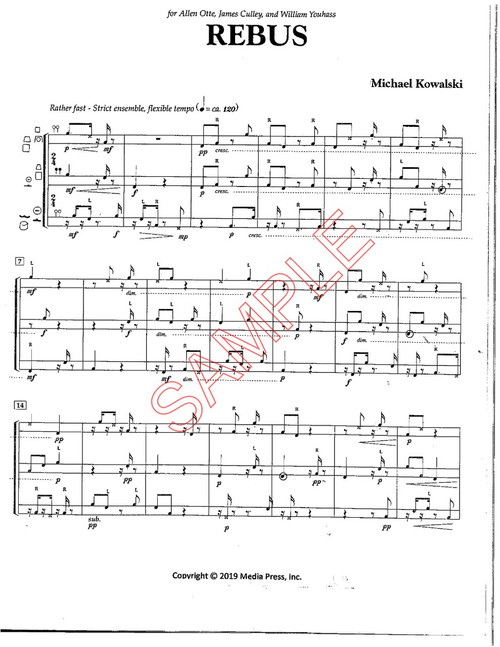Includes score and audio accompaniment (CD).
Want it now? Click here to purchase a digital copy of this product.
Review from Percussive Notes (2021):
And who has thee is mad
Michael Barnhart
According to the editor’s note, “And who has thee is mad” was conceived as a “transitional piece” to be performed immediately after the conclusion of the preceding piece on a program and to lead directly into the piece that follows. Given its stated role as program facilitator, one would expect the five-minute trio to be a bit of a palate cleanser, something light and clever, and otherwise panacean to the challenges of putting a varied program together. However, this is not the case with “And who has thee is mad,” which unabashedly floods the audience with atonality (even toeing the line of dodecaphony) and clattering electronics, which, thanks largely to the musique concrète material derived from heavily-processed guttural sounds, will likely make some in the audience’s skin crawl. Indeed, the piece leaves a strong and lasting impression despite its brief five-minute footprint, and ensembles will need to shrewdly program pieces around it (not the other way around) in order to maximize the intended impact on the program.
Lest anyone get the wrong impression, I should point out that making the audience’s skin crawl seems very likely to be the intent of the piece, and is not an indictment of its quality; if anything, it is a testament to its effectiveness. The work takes its name from, and is based upon, selections from the Greek tragedy Antigone, written by Sophocles around 441 BCE, and some of the text is even reproduced in the score, to allow performers the option of reading it aloud during the performance, if so desired.
The percussion parts are not especially difficult, except for the occasional 3- or 4-note chord and the unique demand in the third part to play back and forth between marimba and vibraphone; as a matter of fact, the percussionists themselves play for less than three minutes. A heavy dose of additive process is used in the repetitive second section of the work, but the complex harmonic language and striking electronics obliterate any sense of simplicity.
The most challenging performance aspect may likely be the level of preparation required to maintain coordination between the percussionists and the electronics. This will make for a rewarding challenge to college percussionists seeking an introduction into the world of playing with electronics. However, if the piece is played with a conductor (not that I would suggest doing so with a trio), the difficulty of the piece shrinks substantially.
If a college percussion ensemble director hopes to challenge the audience, “And who has thee is mad” would be an excellent, operatically dark addition to a thought-provoking program.
—Brian Graiser








